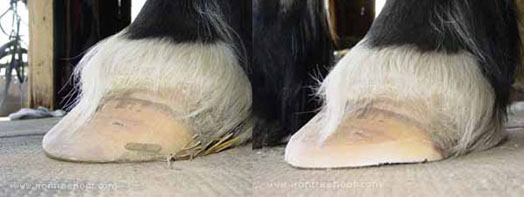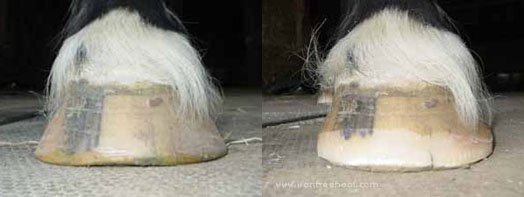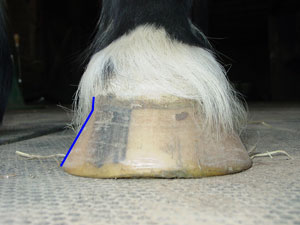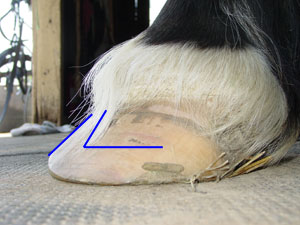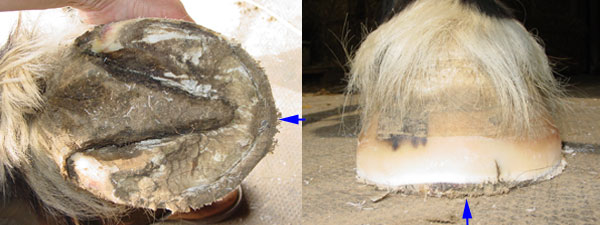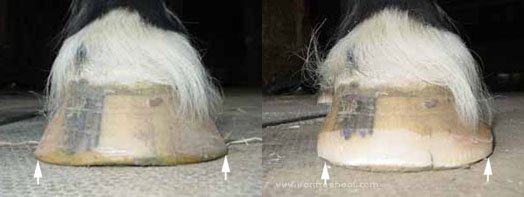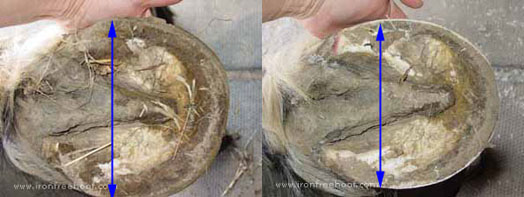|
Flared Flat HoofThis is the first trim I did on this horse. This is an example of a flared flat hoof. His shoes had been pulled a few weeks before I saw him. He had had a terrible bout of laminitis. They pulled his shoes, trimmed him lightly and changed his diet. He was feeling a pretty good when I met him. He was still very sore, but he was on the road to recovery. This is a large Section D - Welsh Cob. His problems began in earnest when he was taken out of heavy work and allowed on pasture. Let me go through the steps that I always go through when I trim.
Lateral View of a Flared Flat Hoof
First Impression Viewing this hoof from the side, the toe looks a little long, it looks a little like a duck bill. When I talk about a first impression, I want you to think about those things that you see as you walk up to the horse. What you see even before you get close.
This hoof is really wide. With all the hair, it is hard to see that the hoof wall is fairly straight at the top but then flares out wildly.
I have highlighted the flare. While the toe looked a little long, this view of the hoof is much more alarming. So my impression is too wide! The balance is pretty good. He was evenly long all the way around. Once again, the hair makes it hard to judge critically. Where is the Coffin Bone?
When I visualize the coffin bone, I don't think it is in-line with the hoof wall. Why do I think that? There are three reasons. One I have to describe because I did not get a good picture of it. I like to look at the pastern of a horse. It helps me figure out the general type of hoof they should have. This guy is a draft. As a typical draft type horse, he has short, upright pasterns. Short, straight, upright pasterns shouldn't have duck bill feet. Think about it, if you took all the hair off, the way his foot is shaped in this photo, it would look like a Thoroughbred hoof. The toe is long and sloping. My point is that the toe is running forward, and his body type suggests a more upright hoof. This is the first reason I believe the hoof wall and coffin bone have slightly parted ways. Reason 2 is that he recently had laminitis. This can weaken the bond between the hoof wall and coffin bone. Chances are, he has a little separation. Whether there is visible separation or not, a bout of laminitis makes it imperative that I address any leveraging forces. The third reason I believe the hoof wall and coffin bone are not aligned is because I can see that he has a stretched white line.
From the edge of the sole to the blue arrow is the width of his white line. It is stretched significantly. You can see the frayed edges of the white line at the bottom of the wall. These two pictures are from his second trim. I did not have a good pictures showing the stretching on his first trim because I had to trim him very carefully the first time. When a horse has had recent laminitis, they are often very fragile and will over react to a trim. The owner of this horse was not confident in my trimming abilities and not sure she wanted to keep him barefoot. Since he had been improving steadily, I thought it prudent to go slow. There are times that a more radical trim needs to be performed on a laminitic hoof, but not this time. Weight-bearing on a Flared Flat Hoof
The priority is to get as much leverage off his walls as I can without making him sore. I will use a mustang roll and bring the weight-bearing surface in as close to the sole as I can. Sole View of a Flared Flat Hoof
My mustang roll has decreased the width of the hoof and it has reduced the wall length. You can see this better in this last photo of before and after. I find a flared flat hoof particularly challenging to trim. Add to that a little laminitis and it can be nerve wracking. I usually don't touch the bottom of this type of hoof. Even if the bars are laid over or tall, I will only lightly soften the edges. I think they play a vital role in supporting a hoof like this. If you are trimming a horse like this, don't be too hard on yourself if the horse gets a little sore. There is a very fine line between trimming enough and trimming too much. Getting the flares under control is very important, so you cannot let the foot continue on its outward path. Want to go back and see other examples of trimming?
|
